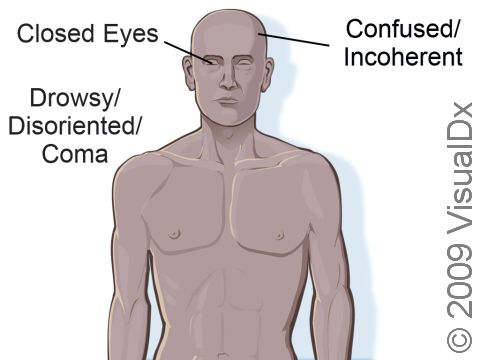Unconsciousness, First Aid
Unconsciousness is an abnormal state in which a person is not alert and not fully responsive to his/her surroundings. Levels of unconsciousness range from drowsiness to collapse and may range in severity from fainting to coma.
Unlike when a person is asleep, someone who is unconscious cannot cough, clear his/her throat, or turn his/her head if in distress. When unconscious, a person is in danger of choking, making it very important to keep the airway clear while awaiting medical care.
First Aid Guide
If you find an unconscious person, try to determine what caused the loss of consciousness. Check to see if he/she is wearing a medical alert tag.
If you can determine what caused the loss of consciousness, call emergency medical services and give first aid for that illness or injury until they arrive. If you cannot determine what caused the loss of consciousness, give first aid for general unconsciousness and call emergency medical services if the person does not revive promptly (ie, within a couple minutes).
- Check the person’s airway, breathing, and circulation.
- If you do not think there is a spinal injury, put the person in the recovery position:
- Position the person lying face up.
- Turn the person’s face toward you.
- Take the person’s arm that is closest to you, and place it to his/her side, tucking it under the buttock.
- Take the person’s other arm, and place it across his/her chest.
- Cross the person’s ankles by placing his/her far leg over the near leg.
- Supporting the person’s head with one hand, pull his/her clothing at the hip, rolling toward you. The person will be on his/her stomach, facing you.
- Bend one arm up and one arm down, to support the upper and lower body.
- Tilt the person’s head back to allow air to move freely in and out of the mouth.
If you do think there is a possible spinal injury, leave the person as you found him/her (as long as breathing continues). If the person vomits or bleeds out of his/her mouth, roll his/her entire body at one time to the side. Be sure to support the person’s neck and back to keep the head and body in the same position while you roll him/her.
- Keep the person warm until emergency medical help arrives.
Note: If the person awakens during the above self-care measures and he/she becomes restless or agitated, attempt to gently restrain him/her.
The following should be avoided in the case of loss of consciousness:
- Do not give an unconscious person anything by mouth; even if he/she regains consciousness, do not give anything until consulting a physician.
- Do not attempt to wake an unconscious person by slapping or shaking him/her or by putting cold water on the person.
- Do not put a pillow under the head of an unconscious person, as this could block his/her airway.
Who's At Risk?
Unconsciousness can be caused by many injuries and types of illnesses. Common causes of unconsciousness are injury to the head by a fall or blow. Causes of unconsciousness specific to fainting can be found in the Fainting topic.
Diabetes affects blood sugar, and too much sugar (hyperglycemia) and too little sugar (hypoglycemia) can lead to unconsciousness in the form of diabetic coma or insulin shock, respectively.
Substance abuse and alcohol abuse, straining during bowel movement, coughing hard, and breathing quickly (hyperventilating) may all cause unconsciousness.
Signs & Symptoms
A person who is unconscious may be:
- Drowsy and/or disoriented; he/she may come in and out of consciousness.
- Confused and incoherent.
- In a coma; he/she may be completely motionless.
Treatments
If the person is not breathing, the physician will restore breathing by clearing the airway and resuscitating him/her.
As loss of consciousness can be caused by many underlying conditions, the physician will conduct tests to determine the scope and treat the illness or injury accordingly.
Visit Urgency
If the person does not regain consciousness promptly, contact emergency medical services. Even if the person does regain consciousness promptly, a medical evaluation should be given to rule out a serious underlying problem.
Seek emergency medical care if the person:
- Has stopped breathing.
- Does not regain consciousness quickly (ie, within 5 minutes).
- Has been injured, especially if he/she is bleeding.
- Has diabetes.
- Is pregnant.
- Is aged greater than 50.
- Is having chest pain, pressure, discomfort, or a pounding or irregular heartbeat.
- Cannot speak, has vision problems, or can’t move his/her arms or legs.
- Has a seizure.
- Experiences loss of bowel control.
Trusted Links
Last modified on October 6th, 2022 at 2:46 pm

Not sure what to look for?
Try our new Rash and Skin Condition Finder
